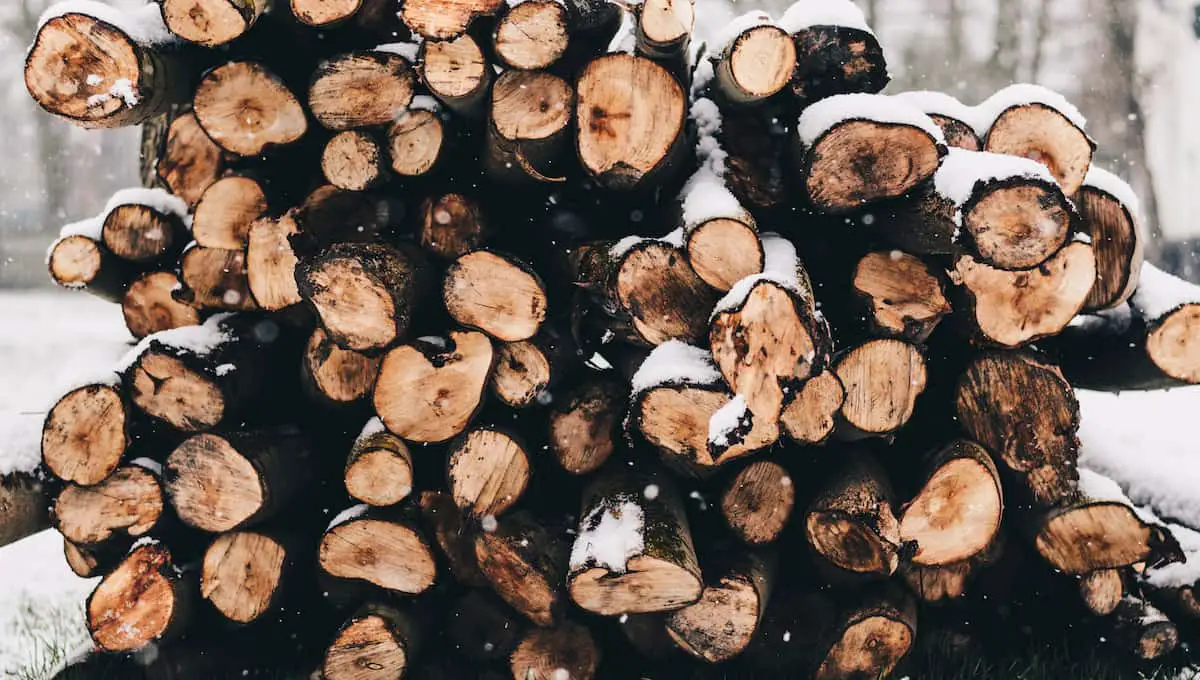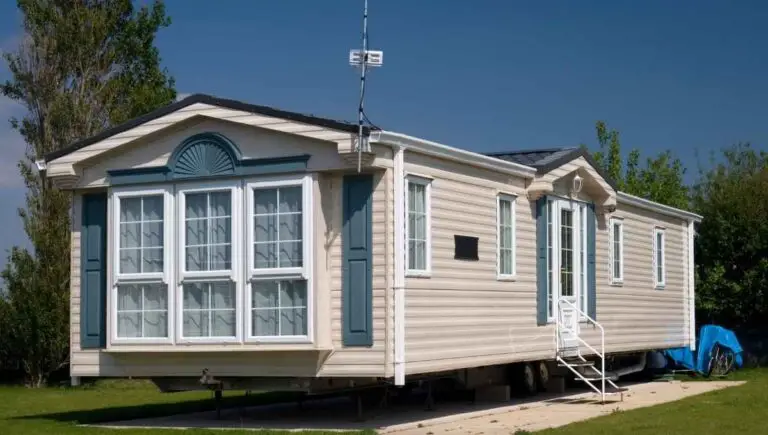How to Store Firewood Outside in Winter

A roaring fire is a quintessential part of winter that helps to make the home feel warm and toasty while keeping your electricity costs down. Learning how to store firewood outside in winter will determine the efficiency in which your wood burns during these colder periods.
The best way to store firewood outside in winter is to find a good location with ample sunlight that’s within walking distance of your home. You will then need to neatly stack the wood into a pile that’s elevated a few inches off the ground. This prevents moisture and insets from ruining the wood.
For people who cut their firewood, the process of chopping down trees and storing firewood outdoors, as well as learning how to store firewood is integral. This is something that should begin months before firewood season begins.
How you keep the cold away depends on several different factors, including the type of wood you use, the time in which you season your wood ahead of the winter months, and how you store firewood outside.
This article looks at the do’s and don’ts on how to store firewood outdoors, where you should store firewood, how to elevate your firewood off the ground to keep it safe from pests, as well as the best materials to cover firewood from the elements (and bacteria), among other things.
Knowing the Differences Between Greenwood and Dead Firewood
Before going into detail on how to store logs outside, you must learn the difference between greenwood and deadwood, especially if you don’t get your local firewood from a supplier, but chop your own.
Using wood that isn’t ready could result in a log pile that smolders quickly, doesn’t conduct much warmth, and creates more smoke than anything else.
Uncut trees contain a lot of moisture for survival. Newly-cut trees still hold an immense amount of water, which needs to be properly dried before use. The process, which is called drying or seasoning, is a process that takes months or years.
In many senses, your wood can be compared to fine wine. If properly cared for, it gets better with age.
Telltale Signs That Your Wood is Ready For Burning
Color
Ready-for-use firewood is grey and less vibrant than newly-chopped wood.
Weight
Cured wood is considerably lighter than water-logged wood.
Sound
Tap your wood with something heavy – if you hear a dull thud, it must dry more still, but if it sounds light and hollow, your wood is free of moisture.
Cracking
Signs of cracking from the middle to the edges of the wood could be signs that you have dry wood. However, it’s important to note that cracking can occur in wood that is still wet and vice Versa.
How you store firewood and where plays a role in how quickly it dries, and therefore, how well your log piles burn when it’s freezing outside.
Moisture meters come in handy when deciphering between completely dry wood and green wood that still holds a lot of moisture. These devices give accurate readings of the moisture content of your firewood. Say goodbye to accidentally burning damp wood! Look under our product’s section for more information.
You might also enjoy our post on How to Stop Icicles From Forming on Your Roof and Gutters
How to Store Logs Outside
When setting up your stack of logs, you must first find a convenient location. Determine the area by the distance from your house: it should be at least 150 feet away but shouldn’t be miles from your home’s interior.
The best way to store logs outside is to place the pile within easy walking distance from your home, bearing in mind that you don’t want to be out in the cold for long, hauling around heavy bundles of wood. If you decide to store it out of the way, make sure you have a wheelbarrow or a firewood cart to carry your logs to-and-from the house.
The Best Places to Store Firewood Outdoors
Mother nature can be unkind to your firewood, with it being particularly vulnerable to snow and rain. At the same time, an unprotected pile of logs is attractive to a variety of wildlife as a source of food and a refuge against the cold. For these reasons, it’s crucial to find weatherproof and pest-proof shelters, which are the best places to store firewood.
We’ve already mentioned that wood must be seasoned, and the best way to do this is to place your stack of wood in direct sunlight. It’s possible to leave firewood in shadier areas, but it’s important to note that your collectin of wood will take longer to dry.
Areas that aren’t recommended include spots under trees because the moisture that accumulates on the leaves will seep into the wood, leaving it damp and unusable. At the same time, if your firewood harbors insects, you don’t want them tunneling through live trees and destroying them.
You can stack your wood against building walls and store firewood next to the house but leave a space between the wall and your wood because air must freely flow between the logs to prevent moisture from building up.
If snow or rain is in the forecast, you should plan ahead by providing shelter for your firewood. Outdoor woodsheds come highly recommended; however, if you don’t have space or cash for a woodshed, the best way to cover firewood is by using sheets of tarpaulin.
Methods for Storing Wood Outside
Wood that is poorly stored, renders disastrous results. Not only can it not be used, but the efforts you put into chopping wood are wasted.
The first lesson on how to store wood is to keep it off the ground. Various insects are attracted to wood, including beetles, termites, and carpenter ants, just to name a few. Leaving piles of wood on the ground is an open invitation for insects whose diet includes different types of wood.
At the same time, not only is a pile of logs messily thrown on the ground an attractive hiding and eating spot for various types of critters, but the moisture from the soil seeps into the wood, resulting in its decomposition.
Keeping Your Wood Off The Ground Is Important For The Following Reasons:
Lack Of Airflow
The danger of stacking your wood directly on the ground is that this doesn’t allow for proper airflow, which is necessary for drying out your timber.
Without aeration, your green wood won’t dry in time for winter.
Too Much Moisture
The soil contains moisture which your wood absorbs, which may accelerate its decay or create mold or fungus.
Insects
If you don’t want your newly-cut wood invaded by unwanted critters or to decay, the best way to store firewood outside is by elevating your stack a couple of inches off the ground so that it’s not touching the soil.
Ways To Store Firewood Outside Include:
- Place your firewood over asphalt or a gravel surface, rather than directly on the ground in the earth. The moisture of the soil not only rots the wood but also lures termites who travel through the soil through a series of mud tunnels to reach the wood.
- If you don’t have asphalt or gravel, lay down some tarp before you begin stacking your wood.
- You can also build your base using materials such as pallets, cinder blocks, or bricks.
- A firewood rack can also raise your logs off the ground and prevent mold, decay, and possible insect invasions.
- Outdoor sheds provide ideal protection from the elements and pesky bugs. (Keep reading further down the page to see our recommended online options).
Tips and Tricks on How to Store Firewood Outside
There are many tried methods for speeding up the process, but the best ways of ensuring that your wood is well seasoned are rather simple.
Keep The Wood Dry
This may sound obvious, but while finding ways on how to store firewood outside, people make mistakes on how to cover firewood.
While it’s essential to protect your wood against rain and snow, the question regarding whether firewood should be covered is yes and no.
How you cover firewood is to shield the top of your wood stack at an angle so that rain runs off it without soaking your bundle thoroughly. However, you should not cover the entire pile because the greenwood needs enough air to dry. Therefore, you must leave the sides of your woodpile uncovered so that there’s enough circulation.
So should you cover firewood or not? It’s up to you but if you do. You can’t go wrong with this 12-foot log cover and rack.
Start Early, Burn Late
Your preparations on how to store firewood outside in winter should start as early as summer because your wood will take time to dry.
Size Matters
Unless you plan on placing large chunks of wood into a bonfire, it’s definitely a good idea to split your wood before learning how to keep firewood dry outside.
Splitting firewood when it’s unseasoned is easier because it’s not as dense as mature deadwood. At the same time, wood that’s cut or split won’t take as long to dry as rounded logs.
The reason for this is because splitting removes some of the bark, which is the part of the wood that retains the most moisture. With that part of the timber removed, wood can more easily dry out.
Not only does splitting wood aid in the drying process, but it makes for better wood burning that’s easier to ignite.
Implement The Right Stacking Techniques
Believe it or not, there’s a right way to stack, and incorrect implementation could result in wood that doesn’t dry fast enough or at all.
We’ll look at stacking techniques in-depth later on, but for now, it’s important to note that for moisture to evaporate, both ends of a wood piece must be exposed to sun and wind.
The Wood You Buy
If you purchase wood, acquire it from a reputable supplier. At the same time, be prepared to pay more for quality. Cheaper woods, such as pine, burn quickly and produce coals that aren’t as hot.
You’ll find that you’ll be constantly replenishing your supplies, which ends up being more expensive in the long haul.
The Best Way to Stack Wood Outdoors
How you place your wood is as essential as how to store your firewood outdoors because it can impact the rate at which your firewood dries.
Therefore, before you ask yourself, “where to store firewood at home?”, you should first know how to stack your firewood properly. Failure to do so could result in wood that remains damp and rots or becomes infested by uninvited and unwanted creatures that render the pieces of wood unusable.
Chopping your wood only to dump it in loose piles on the ground is the worst thing you can do because insects and moisture will quickly destroy your firewood. Therefore your hard toil is in vain. Wood packing is a skill; some might call it a lost art that must be learned before the wood-burning season begins.
If you decide not to stack your wood directly on concrete or some other soilless ground, remember that it’s vital to lay the foundation for firewood storage outside. We’ve recommended pallets and bricks, but two by four structures work just as well, plus they’re inexpensive materials that can be purchased from any hardware store.
Once the groundwork is constructed, you can start laying down your wood, beginning with the more substantial pieces of wood at the bottom. You must do this to create a balanced stack that isn’t in danger of falling.
How high you stack your wood is up to you, but the pile won’t be stable if it’s taller than four feet. An avalanche of sliding wood is a serious matter and could result in potentially severe injuries for you or your family member. At the same time, you need to be able to reach the top of the woodpile.
You must pack your wood tin an orderly fashion but loosely to keep firewood dry outside. Leave spaces between the pieces so that air can move freely, thus quickening the process of seasoning.
There is much debate about which approach to stacking works best. While layering your wood using traditional methods is fine, take a look at the below technique that optimizes safety while drying your wood efficiently.
Norweigian Round Stacking
People are quick to praise this method because it doesn’t require the same precision as regular or square packing, which needs each log to be placed just-so on top of the other. At the same time, people have reported that round stacking is more stable, thus minimizing the possibility of tumbling wood.
Round stacking consists of vertical wood that’s built in a circular formation. Once the circle is built up into a cylinder, logs are placed inside the middle to provide support and prevent your logs from collapsing inwardly. Once the formation is complete, standing tall at approximately three-and-a-half feet high, place a layer of small logs with the bark facing upwards on top.
Not just aesthetically pleasing, round stacking cuts the time you spend packing wood and is described as one of the best ways to store firewood outside.
Alternative Storage Solutions
If you’re looking for alternatives to store your wood but aren’t thrilled at the thought of constructing wood stacks outdoors, a woodshed keeps firewood dry and provides protection against the elements. The environment also offers you the opportunity of separating your dry wood from your drying wood.
A woodshed in an urban environment allows you to keep logs in confined spaces.
Storing firewood under decks or storing firewood in deck boxes are also viable alternatives. See our product section for recommendations.
How Do You Store Firewood Indoors?
Remember that while there may be a convenience in storing firewood indoors, it’s not a good idea for two reasons.
Firstly, because wood is a natural element, you’re inviting a host of bugs and rodents indoors, including the highly destructive termites. Trust us when we say, you do not want to have to deal with termites in your firewood. Secondly, wood needs to be outdoors to dry under direct sunlight and exposed to the wind properly.
If it’s not possible to store your firewood in your yard, one-way to store firewood indoors is with a properly installed rack, which will keep your firewood piles off-the-ground and away from potential pests. Elevate your wood indoors with a Sunnydaze Outdoor and Indoor Firewood Log Rack.
Storing firewood in the basement or storing firewood in the garage are other considerations, given that these spaces are adequately aerated. Without circulation, moisture will build-up, which could lead to your log piles rotting and decaying.
Firewood Drying Time by Species
When it comes to choosing your firewood, some types are better than others.
How well a fire burns and the amount of heat that’s conducted depends upon two factors: the density and water content of firewood that’s used. The general rule of thumb is that the denser and drier your wood is, the better and warmer your fires will be for the colder months ahead.
If you plan to snuggle up in front of a fire with hot chocolate, you do need to plan ahead, which involves carefully selecting your firewood, making a mental note of the different firewood drying times, so that you have enough dried wood stored to last you the season.
Choosing Between Hardwood And Softwood
The difference between the two types of wood is that the former is denser than the latter. There are pros and cons to using each, but overall, while it’s more expensive, hardwood burns hotter and for a more extended period.
Seasoned Versus Unseasoned
We’ve mentioned previously that drying wood in winter is essential because the effects of unseasoned timber are not just ineffective and unpleasant, but can be outright dangerous.
A lot more residue is left behind with unseasoned wood, which can lead to chimney blockages, and in turn, an uncontrolled fire. If you do prefer this wood, burn it outdoors in a bonfire or fire pit for reasons of safety instead.
Best Types Of Firewood
When firewood is first cut down, it comprises between 50-60% water. For wood to burn correctly and give off enough heat, it must have a water content of less than 20%. While the time it takes for the wood’s moisture to evaporate varies between different types of wood, you should plan for approximately six months to a year if you want dry firewood in time for winter.
There are several types of firewood from which to choose, depending on individual preference. However, avoid softwoods, such as pine, cottonwood, and cedar, because these don’t burn well and take longer to cure than hardwoods.
Ash firewood is a popular choice because it burns well and gives off ample heat. However, ash firewood drying times are lengthy, so make sure you chop the wood months in advance. Cherry firewood has similar requirements in that it should be thoroughly seasoned. An added benefit of using cherry firewood is that it releases a pleasant aroma while burning.
Red oak firewood and white oak firewood is easily accessible but do require extra attention and seasoning. Otherwise, these types of wood won’t burn as steadily as they should.
Equipment You May Need to Help You Haul and Store Firewood Easily
In this section, we’ve compiled a list of must-haves that you may need to efficiently store firewood.
Readywares Waxed Canvas Firewood Log Carrier
If you’re looking for a firewood bag to lug around your firewood from outside, the Readyware Log Carrier is sturdy and weather-resistant.
Why buy it? Its waxy material doesn’t just withstand lousy weather; it’s also a simple yet attractive design that you can store by the fireplace.
Wow Factor: It’s large enough to carry sizeable pieces of wood.
Learn more here.
Hybrid Covers (Log Rack)
You should cover your firewood with one of these hybrids covers, which offers year-round protection.
Why buy it? This cover offers protection, not just from the elements, but also a myriad of pests.
Wow Factor: Allows for ample air circulation, so that you don’t have to worry about wet or rotting wood caused by moisture build-up.
Learn more here.
Firewood Beauty Firewood Log Carrier
The worst part of winter is carrying around heavy pieces of winter when it’s freezing. This log carrier does the hard work for you.
Why buy it? Moves your firewood from point a to point b with ease.
Wow Factor: Its smart design has an arch that securely holds large piles of firewood in place without toppling over.
Learn more here.
Wood Moisture Meter
Measures the level of moisture in various types of wood, including firewood.
Why buy it? Tired of burning firewood that’s not completely dry, resulting in a smoky and ineffective fire? A wood moisture meter gives accurate readings, so you’ll know when your wood is well-seasoned and ready for burning.
Wow Factor: The device is highly sensitive to wetness, and it’s easy-to-use.
Learn more here.
Recap: Everything You Should Know on How to Store Firewood Outside
If you live in a cold region, you probably envisage spending several evenings warmed up in front of a fire during winter. However, if you haven’t adequately prepared for these cold months by implementing the best ways to store firewood, you’re likely in for a rough time.
This article has given an overview of where to store firewood during sub-zero temperatures, ensuring that your wood is dry and well-seasoned. We’ve learned that it’s essential to:
- Differentiate between types of wood and which are better to use for warmer, long-lasting fires. For example, seasoned wood, which is another term for dry logs, is more efficient than unseasoned or wet wood, which is harder to burn, conducts less heat, and can result in devastating house fires.
- There are telltale signs that your wood is ready, including grey coloring, it’s lighter than wet firewood, and makes a hollow sound on impact.
- We’ve listed a few of the best ways to store firewood outside, but some of the most basic techniques are to keep woodpiles off the floor, away from moisture and pests that are attracted to wood.
- Store firewood inside isn’t always recommended. However, one way to store firewood indoors is with raised firewood racks.
- There are various ways that you can elevate your wood from the ground, depending on what you prefer. Some people use two by four wooden structures to lay the foundation, while others use fire racks, which are easy-to-assemble and require less DIY work.
- How you stack firewood outside has also be summarised, but if you should take away anything from this article, it’s: you must stack your wood neatly but loosely, allowing air to circulate in amongst your woodpile. If moisture is trapped between the logs, your firewood will likely rot, and your labor of cutting and hauling wood is wasted because you will have to throw these pieces away.
- Should you cover firewood or not? You should protect your wood from the elements with covers that shield the top layer of your wood, but make sure to keep the sides uncovered. Both endpoints of your wood pieces must be exposed to allow them to dry.
- We’ve included several Amazon products to help you get started with your wood chopping, storing, stacking, and seasoning. Whether you’re looking to purchase wood racks or firewood covers, we’ve included all the season must-haves.
- Before you’ve even begun curing and stacking your wood, you must split larger pieces to aid with the seasoning process, which basically means chopping your wood into smaller pieces so that it dries quickly and burns better.
- There are different types of firewood available but hardwood is a better choice than softwood because the one is denser and burns better than the other. Recommended timber include ash firewood, as well as oat, granted both types are well seasoned.






